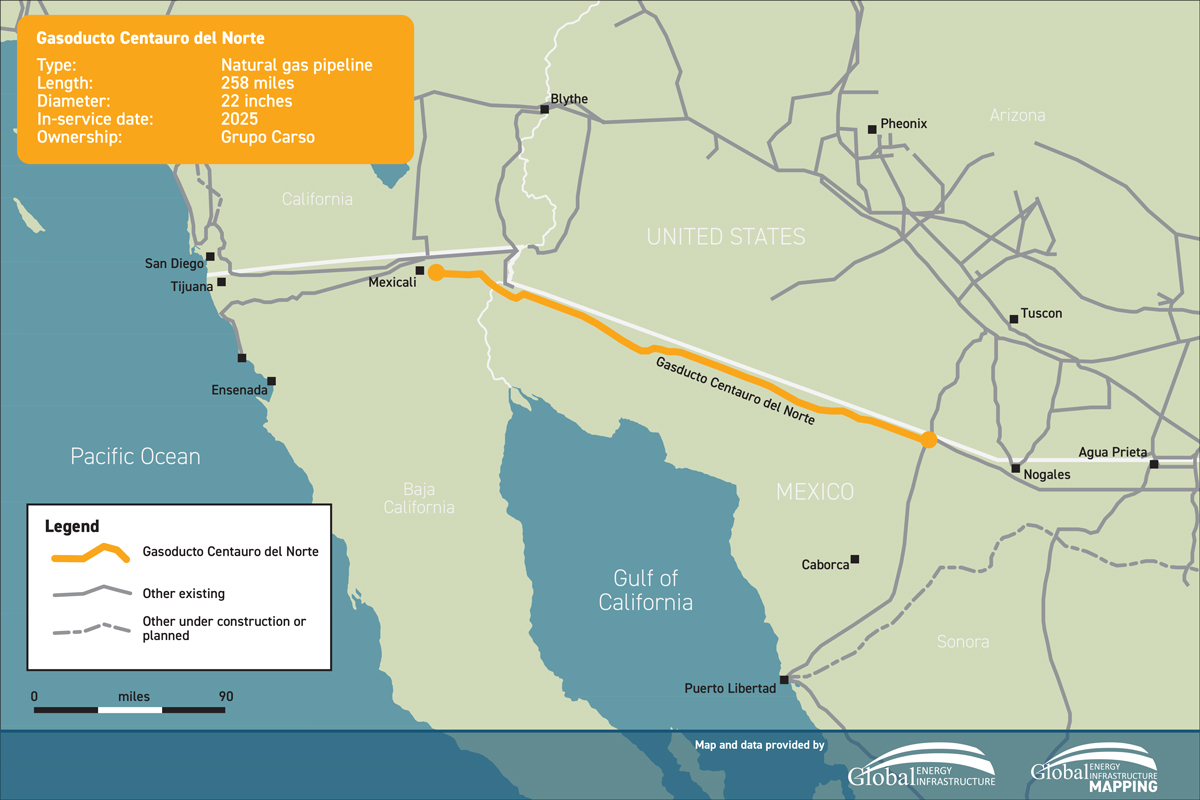December 2024, Vol. 251, No. 12
Features
Spotlight on Mexico: Construction on Centauro del Norte Pipeline Begins
By Mauro Nogarin, Latin America Correspondent
(P&GJ) – Nine months after signing the agreement with the Federal Electricity Commission (CFE), Grupo Carso began construction of the first section of the Centauro del Norte Gas Pipeline (GCN) located in Baja, California.
The main purpose of this project is to supply natural gas to feed the thermoelectric plants currently under construction and owned by the state-owned company Comisión Federal de Electricidad (CFE).
The thermo-electric plants are the San Luis Río Colorado Combined Cycle Plants in Sonora and the González Ortega in Baja California, as well as the Altar Internal Combustion Plant, also in Sonora.
The gas pipeline will have a total length of 274 miles (441 km), with a diameter of 36 inches. It is divided into two sections: Section 1 runs from San Luis Río Colorado to Mexicali 47 miles (76 km), Baja California, while Section 2 at the municipality of Caborca and runs to San Luis 227 miles (365 km) in Sonora.
According to the work Schedule, construction of the first section of the pipeline is Schedule to begin by the end of 2025 and the other section by 2027.
The gas will flow from west to east, where the gas will flow through the interconnection with the Rosarito Pipeline and subsequently, the pipeline will be connected to the Samalayuca-Sásabe transportation system, in order to ensure an efficient transportation network in the northern part of the Baja California and Sonora regions.
Section I of the GCN has a 36-in pipeline capacity of 400 MMcfd and a design pressure of 1,440 psig and includes a compression station, sectioning valves, a control and communications building, workshop/warehouse and a storage center for pipeline maintenance located in the town of Pitiquito, Caborca.
The Centauro Norte pipeline is divided into two sections:
• Section I consists of the interconnection of the beginning of the pipeline until reaching the interconnection in San Luis Río Colorado with Section II of the GCN pipeline, with a diameter of 36-in and an approximate length of 47.5 mi (76.5 km).
• Section II of the pipeline consists of a 36-in pipeline with the same diameter of 36 in and a length of approximately 227 miles (365 km), from the reception point, located at the interconnection with the Samalayuca-Sásabe Natural Gas Transportation System (SAMSA) in the municipality of Caborca, Sonora, to the interconnection with the Centauro del Norte Section I pipeline.
Regarding the construction of the new infrastructure, the project currently has approval for the first section, according to the guidelines established by the Government of Baja California at the beginning of September.
During the construction phase of this project, the total area reserved for the companies along the pipeline route will be 945,000 hectares, of which 420,000 hectares will be permanently occupied to guarantee security during the 35 years of the pipeline’s useful life.
The right-of-way of the Centauro del Norte gas pipeline has a minimum width of 50 feet (14 meters) for permanent occupation and 82 feet (25 meters) for temporary occupation, according to the requirements for the construction of the new infrastructure.
From a geological point of view, Section I of the Centauro del Norte Gas Pipeline is located in the Sonora desert province — an area characterized by deposits of sedimentary rocks such as sandstone, as well as being an extremely arid region with high temperatures and low soil humidity.
Most of its route runs parallel to the Mexicali-Algodones state highway for the first 31 miles (50 km) — a road that is considered an important connection between the city of Mexicali and the main towns in the valley southeast of the city.
In total, the Centauro del Norte (GCN) pipeline crosses the railroad tracks seven times, the Mexicali-Los Algodones state highway eight times and a fiber optic line twice, in addition to crossing five intersections with other highways, two gas pipelines, fourteen drainage canals and thirteen irrigation canals.
At the main crossings of highways, freeways, roads and railroads, the pipeline will be installed by horizontal drilling; at crossings with roads or other roads with little traffic and no pavement, the pipeline will be installed in the open air, implementing protections in accordance with standards.
In the crossings of small streams and rivers, they will be crossed by means of an open-cast crossing, while in the case of larger rivers and canals, they will be crossed by means of horizontal directional drilling.
The position of the six 36-inch sectioning valves were defined in accordance with Mexican standard NOM-007-ASEA-2016, which are fed through a low-to-medium voltage connection and also have a cathodic protection station.
Section I is formed by API 5L X70 steel ducts with an external fusion bonded epoxy (FBE) coating, a cathodic protection system and insulating gaskets at the delivery and venting points.
The automatic shut-off valves, metering regulation and control stations (MR&C) are located at metering and flow regulation stations, and they are connected to the monitoring center through the SCADA system.






Comments